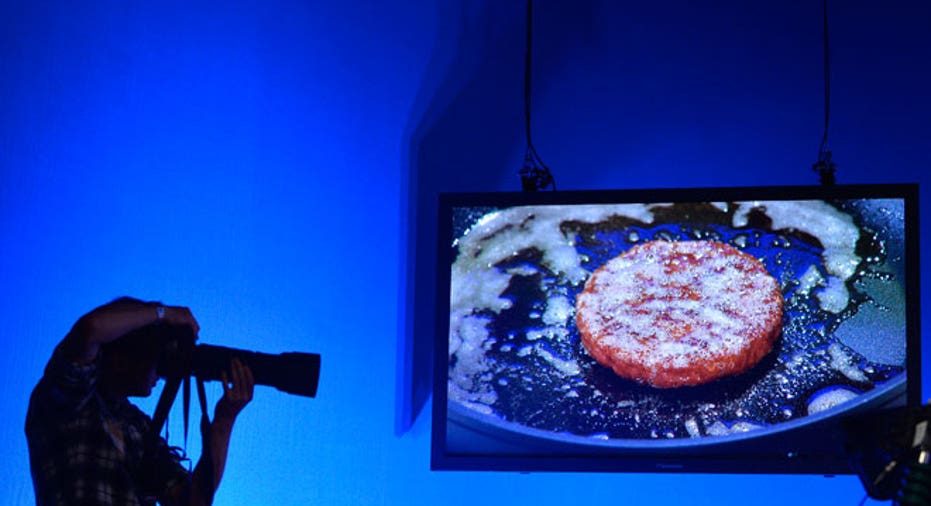Test-Tube Meat Coming Soon to a Supermarket Near You

The burger was seasoned with salt and fried in a sizzling pan, yet it originated not from a hearty cow on a farm but from a petri dish in a lab by a scientist.
Science fiction? Think again. Cultured beef, made in a controlled setting using the cells of bovine, was doused with fresh support this week as the first humans publicly tasted burgers made through this controversial process.
It may not sound all that appetizing to some right now, but cultured meat, touted for its numerous benefits like potentially curing food shortages, may soon be flying off the shelves of grocery stores.
Google (NASDAQ:GOOG) co-founder Sergey Brin, who is a personal investor in a years-long project headed by scientist Mark Post of Maastricht University in the Netherlands, says he is optimistic it can "really scale by leaps and bounds."
In a video supporting the project, a Google Glass-donning Brin said the project seems like it's "on the cusp of viability."
Of course, in-vitro meat still has negatives, including the fact that it costs more than $300,000 to make, but there is optimism that within the next 10 to 20 years it will transform the way people eat, potentially altering the beef industry forever.
Saving Planet Earth?
More than 10 billion farm animals were killed for human consumption in 2010, according to Farm USA. As the world’s population grows to an estimated nine billion by 2050, there is fear meat manufacturers won’t be able to keep up with demand.
“By 2050, the demand for meat will double,” Post said. “Unless we make some changes in our how produce meat on this planet, we’re in for a terrible reckoning.”
Today, meat production uses 1,500 gallons of water per one pound of meat, takes up some 70% of the earth’s arable land and contributes to 18% of greenhouse gas emissions, according to Post. Oxford University in a recent study said cultured beef would require 45% less energy than traditional farms, 99% less land, 96% less water and cause 96% fewer greenhouse gas emissions. Other benefits include the quicker time to produce it (just months), versus the years it takes to raise an animal.
"This is a technology to which business is going to have to adapt," said Farm Sanctuary Advocacy Director Bruce Friedrich, who has been a vegan for 25 years and spearheaded animal protection programs for 17 of them.
He doesn’t see big meat companies like Tyson Foods (NYSE:TSN) going extinct, but adapting as the costs to produce shift in favor of in-vitro meat.
The three major U.S. meat manufacturers, Smithfield Foods (NYSE:SFD), Hillshire Farms (NYSE:HSH) and Tyson would not comment on this week’s experiment.
The American Meat Institute did not immediately respond to FOX Business for a comment.
Did You Say Frankenmeat?
In-vitro meat, of course, has many opponents – which is partially to blame for its vast array of condescending nicknames, including frankenbeef, shmeat and test-tube beef.
It also faces hurdles, including the fact that it costs $300,000 to make just one patty. While the price is expected to come down -- perhaps even lower than farm-raised beef -- more private backing is needed.
At the same time, while cultured beef is far leaner than beef from farmed cows, the U.K.-based Guild of Fine Food, which advocates foods with complex flavors made through traditional methods, warns it might demand a high level of artificial flavoring and seasonings like salt and sugar.
KK Catering, which operates food trucks in the U.K. and sources its food from local farmers, expressed concerns regarding the implications this could have for small businesses and farmers.
“Lab grown meat is billed as an ethical, sustainable and environmentally friendly, in probability it would destroy businesses and communities involved in traditional farming,” said Kevin Anderton, managing director at KK Catering.
Today in-vitro meat remains just a proof of concept, but supporters say consumers will one day down the road have the choice of two identical meat products at the supermarket -- one that is fabricated in a lab.
"Some people think this is science fiction, it's not real, it's somewhere out there…I actually think that's a good thing,” Brin said. "If what you are doing isn’t seen as science fiction by some people, then it’s not transformative enough."



















